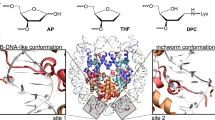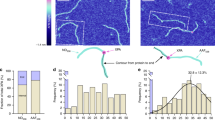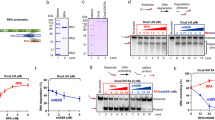Abstract
The solution structure of the central domain of the human nucleotide excision repair protein XPA, which binds to damaged DNA and replication protein A (RPA), was determined by nuclear magnetic resonance (NMR) spectroscopy. The central domain consists of a zinc-containing subdomain and a C-terminal subdomain. The zinc-containing subdomain has a compact globular structure and is distinct from the zinc-fingers found in transcription factors. The C-terminal subdomain folds into a novel α/β structure with a positively charged superficial cleft. From the NMR spectra of the complexes, DNA and RPA binding surfaces are suggested.
This is a preview of subscription content, access via your institution
Access options
Subscribe to this journal
Receive 12 print issues and online access
$189.00 per year
only $15.75 per issue
Buy this article
- Purchase on Springer Link
- Instant access to full article PDF
Prices may be subject to local taxes which are calculated during checkout




Similar content being viewed by others
Accession codes
References
Cleaver, J.E. & Kraemer, K.H. Xeroderma pigmentosum. In The metabolic basis of inherited disease (eds Scriver, C.R. et al. ) 4393– 4419 (McGraw-Hill, New York; 1995).
Tanaka, K. et al. Nature 348, 73– 76 ( 1990).
Robins, P., Jones, C.J., Biggerstaff, M., Lindahl, T. & Wood, R.D. EMBO J. 10, 3913– 3921 (1991).
Jones, C.J. & Wood, R.D. Biochemistry 32, 12096– 12104 (1993).
Asahina, H. et al. Mutat. Res. 315, 229– 237 (1994).
Kuraoka, I. et al. Mutat. Res. 362, 87– 95 ( 1996).
He, Z., Henricksen, L.A., Wold, M.S. & Ingles, C.J. Nature 374, 566– 569 (1995).
Li, L., Lu, X., Peterson, C.A. & Legerski, R.J. Mol. Cell. Biol. 15, 5396– 5402 (1995).
Saijo, M., Kuraoka, I., Masutani, C., Hanaoka, F. & Tanaka, K. Nucleic Acids Res. 24, 4719– 4724 (1996).
Park, C.-H., Mu, D., Reardon, J.T. & Sancar, A. J. Biol. Chem. 270, 4896– 4902 (1995).
Nocentini, S., Coin, F., Saijo, M., Tanaka, K. & Egly, J.-M. J. Biol. Chem. 272, 22991– 22994 (1997).
Li, L., Elledge, S.J., Peterson, C.A., Bales, E.S. & Legerski, R.J. Proc. Natl. Acad. Sci. USA 91, 5012– 5016 (1994).
Li, L., Peterson, C.A., Lu, X. & Legerski, R.J. Mol. Cell. Biol. 15, 1993– 1998 ( 1995).
Nagai, A. et al. Biochem. Biophys. Res. Commun. 211, 960– 966 (1995).
Mu, D., Hsu, D.S. & Sancar,A., J. Biol. Chem. 271, 8285– 8294 (1996).
Morita, E.H. et al. Genes Cells 1, 437– 442 ( 1996).
Blake, P.R. & Summers, M.F. Adv. Biophys. Chem. 4, 1– 30 (1994).
Berg, J.M. Proc. Natl. Acad. Sci. USA 85, 99– 102 ( 1988).
Cavanagh, J., Fairbrother, W.J., Palmer III, A.G. & Skelton, N.J. Protein NMR spectroscopy (Academic Press, San Diego; 1996).
Satokata, I., Iwai, K., Matsuda, T., Okada, Y. & Tanaka, K. Gene 136, 345– 348 (1993).
Moggs, J.G., Yarema, K.J., Essigmann, J.M. & Wood, R.D. J. Biol. Chem. 271, 7177– 7186 ( 1996).
Aboussekhra, A. et al. Cell 80, 859– 868 ( 1995).
Bochkarev, A., Pfuetzner, R.A., Edwards, A.M. & Frappier, L. Nature 385, 176– 181 (1997).
Hu, W. & Zuiderweg, E.R.P. J. Magn. Reson. B 113, 70– 75 (1996).
Hu, J.-S., Grzesiek, S. & Bax, A. J. Am. Chem. Soc. 119, 1803– 1804 (1997).
Brünger, A.T. X-PLOR, Version 3.1 (Yale University Press, New Haven, Connecticut; 1993).
Koradi, R., Billeter, M. & Wüthrich, K. J. Mol. Graph. 14, 51– 55 (1996).
Laskowski, R.A., Rullmann, J.A.C., MacArthur, M.W., Kaptein, R. & Thornton, J.M. J. Biomol. NMR 8, 477– 486 (1996).
Kraulis, P.J. J. Appl. Crystallogr. 24, 946– 950 ( 1991).
Merritt, E.A. & Murphy, M.E.P. Acta Crystallogr. D 50, 869– 873 (1994).
Nicholls, A., Sharp, K.A. & Honig, B. Proteins Struct. Funct. Genet. 11, 281– 296 (1991).
Acknowledgements
We thank E.H. Morita, M. Shimizu, T. Shimizu, and M. Maeda for discussions. We thank M. Wäelchli for a critical reading of the manuscript. This work was supported by grants to M.S. and K.T. from the Ministry of Education, Science, and Culture of Japan. M.S. was also supported by the Ciba-Geigy (Japan) Foundation for the Promotion of Science. This work was partly supported by a research grant to K.T. and K.M. from the Human Frontier Science Program.
Author information
Authors and Affiliations
Corresponding author
Rights and permissions
About this article
Cite this article
Ikegami, T., Kuraoka, I., Saijo, M. et al. Solution structure of the DNA- and RPA-binding domain of the human repair factor XPA. Nat Struct Mol Biol 5, 701–706 (1998). https://doi.org/10.1038/1400
Received:
Accepted:
Issue Date:
DOI: https://doi.org/10.1038/1400
This article is cited by
-
Xeroderma pigmentosum A homolog from Hydra partially complements DNA repair defect in human XPA-deficient cells
Journal of Biosciences (2021)
-
Single molecule analysis reveals monomeric XPA bends DNA and undergoes episodic linear diffusion during damage search
Nature Communications (2020)
-
Genetic variants in RPA1 associated with the response to oxaliplatin-based chemotherapy in colorectal cancer
Journal of Gastroenterology (2019)
-
Metal binding mediated conformational change of XPA protein:a potential cytotoxic mechanism of nickel in the nucleotide excision repair
Journal of Molecular Modeling (2016)
-
TFIIH: when transcription met DNA repair
Nature Reviews Molecular Cell Biology (2012)



